Dynamic Load Management in Modern Grid Systems Using an Intelligent SDN-Based Framework
Abstract
1. Introduction
1.1. Background and Motivation
1.2. Need for Intelligent Dynamic Load Management
1.3. Work Contribution
Features and Advantages of the Proposed Method
- The Union of Heterogeneous Domain Models as a Co-Simulation Environment: The power system analysis, conducted using PandaPower, and network control, using Mininet via the POX SDN controller, have been maintained separately until now. With our approach, a unified framework is created enabling real-time control of power network systems involving the exchange of control information between two different domains more quickly and effectively.
- Compatibility via MQTT: MQTT is a lightweight protocol used as a messaging interface between two heterogeneous domains. In the proposed technique, the MQTT enables Intelligent Electronic Devices (IEDs) to deliver their transformer load data to the SDN controller in real time. It means this framework with MQTT can handle changes in decisions without pausing any simulations.
- Customized and Modular Approach: In our proposed method, the user-defined topology, transformer thresholds, and SDN logic are modular, and they can be modified quickly for use on different networks.
- Application of an AI Load Balancer (AILB) for Control Techniques: The proposed framework uses an SDN controller with a load balancer in the form of AI-powered algorithms that replace static control logic with adaptive responses to achieve maximum efficiency in terms of high power factor and decrease in overloading of power transformers.
- Dynamic Load Optimization Mechanism: With the real-time determination of overloaded (>90%) and under-utilized (<40%) transformers and redistributing the load to maintain all transformers under 70%, the reliability of the system increases, with avoidance of overloading and reduction in energy loss.
1.4. Research Objectives
- To monitor real-time transformer load data.
- To enable the SDN (POX) controller to redistribute load and prevent overloading phenomena.
- To improve system operational efficiency (i.e., enhance dynamic load distribution with faster response time at reduced reactive losses, etc.), reduce transformer overloading, maintain high power factor, and minimize losses.
1.5. Paper Arrangement
2. Literature Review
3. Research Methodology
3.1. Working on the Proposed Framework
- Step 1:
- (a)
- Power Flow Analysis: Calculation of bus voltage, branch loading, power loss, active power, reactive power and power factor of each transformer, and overall system power factor.
- (b)
- Transformer Loading: Analysis of overloading (SLoad ≥ 0.90 Rcapacity) and under-utilization (SLoad ≤ 0.40 Rcapacity) scenarios among all transformers.
- (c)
- Load Distribution: Simulation of the scenarios to test where the load is redistributed or how the load characteristics are modified through IEDs under SDN controller influence.
| Algorithm 1: Designing Power Network Topology on PanadaPower and Performing Load Flow Analysis | |
| |
- Step 2:
- (a)
- Monitoring: Measuring the voltage, current, and power factor, and recording the real, apparent, and reactive power of each transformer using a sensor (current transformers, CTs; potential transformers, PTs).
- (b)
- Communication via Message Queuing Telemetry Transport (MQTT): The data obtained from each transformer is routed to the SDN controller using MQTT communication messenger.
- (c)
- Action performed as per instruction from SDN controller: Opening and closing of circuit breakers, relays, and rerouting and shift of transformer load as per the instructions of the SDN controller.
| Algorithm 2: Load Condition Monitoring and Alerting System | |
| |
| |
| |
- Step 3:
- Step 4:
| Algorithm 3: IED Status Reporting and MQTT Messaging | |
| |
- Main condition: (If SLoad (any transformer) ≥ 0.90 Rcapacity){Shift load to the under-utilized transformer with SLoad (any transformer) ≤ 0.40 Rcapacity}Else{Redistribute the load among transformers so that the load parameter satisfies the condition SLoad (all transformers) ≤ 0.70 Rcapacity}
- The pseudocode of the proposed algorithm (AI load balancer) is explained in Algorithm 4. The AILB algorithm first classifies transformers (T1–T4) by their load: those above 90% are classed as overloaded, and those below 40% are classed as under-utilized. The SDN controller shifts load among power transformers as needed to help prevent both scenarios mentioned above. If both defined conditions are met (i.e., there are overloaded and under-utilized transformers in a user-defined system), then the algorithm repeatedly transfers extra load from the overloaded transformer to the under-utilized transformer. If similar transformers cannot be found, the algorithm goes on to a global method, adding all the power together and giving each transformer a load according to their 70% capacity. The outcome is more level use of the network, less chance of transformer damage, and better performance.
| Algorithm 4: AI Load Balancer (AILB): Algorithm for Intelligent Dynamic Load Management in Power Transformers | |
| Input: T ← Dictionary mapping transformer ID to current apparent load (SLoad) R ← Dictionary mapping transformer ID to rated capacity (Rcapacity) Output: Updated Load Distribution T after Load Balancing | |
| |
| |
3.2. Mathematical Modelling of the Proposed Framework
- Let the transformers be denoted as Trans = [Trans_1, Trans_2, Trans_3, Trans_4], and each Trans (i) has rated capacity Rcap(i) in MVA.
- Load Assigned: Ldi (t) at time t
- The load status description is given as follows:
- Main objective function:
- Constraints:
3.3. Software/Tools Used in This Co-Simulation Framework
- (a)
- PandaPower (https://pandapower.readthedocs.io/en/latest/, accessed on 20 April 2025), version 3.1.1.
- (b)
- Mininet Network Emulator (https://mininet.org/download/, accessed on 20 April 2025), version 2.3.0.
- (c)
- POX SDN controller (https://brianlinkletter.com/2015/04/using-the-pox-sdn-controller/, accessed on 20 April 2025), version Python 3.
- (d)
- Gnuplot (http://www.gnuplot.info/download.html, accessed on 20 April 2025), version 6.0.2.
3.4. Simulation Parameters
4. Results and Discussions
4.1. Case A: We Consider All the Transformers in the User-Defined Topology to Be Under Normal Operating Conditions
Summary of Results in Case A
4.2. Case B: There Is a Disturbance in the Load Parameters of Transformers and the AILB Algorithm Is Not Utilized
Summary of Results in Case B
4.3. Case C: Redistributing Load Parameters of Transformers with the AILB Algorithm
- Main condition: If (SLoad (any Transformer) ≥ 0.90 Rcapacity){Shift load to the under-utilized transformer with SLoad (any transformer) ≤ 0.40 Rcapacity}Else{Redistribute the load among transformers so that the load parameter satisfies the condition SLoad (all transformers) ≤ 0.70 Rcapacity}
- The result of the power load flow analysis is shown in Table 5.
| Transformer | RCap (KVA) | %L | PReal (KW) | PApparent (KVA) | PReactive (KVAR) | Current (A) | Voltage (V) | PF |
|---|---|---|---|---|---|---|---|---|
| Trans_1 | 1000 | 60 | 600 | 631.59 | 197 | 912.1 | 400 | 0.95 |
| Trans_2 | 1000 | 50 | 500 | 526.29 | 164.49 | 759.9 | 400 | 0.95 |
| Trans_3 | 1000 | 65 | 650 | 684.19 | 213.19 | 987.21 | 400 | 0.95 |
| Trans_4 | 1000 | 60 | 600 | 631.59 | 197.01 | 912.1 | 400 | 0.95 |
| Total | 1000 | - | 2350 | 2473.69 | 771.69 | - | 400 | 0.95 (Bal) |
Summary of Results in Case C
4.4. Case D: The Proposed Algorithm (AILB) Is Compared with an Already-Existing Algorithm to Evaluate the Performance
Summary of Results in Case D
5. Conclusions
Author Contributions
Funding
Institutional Review Board Statement
Informed Consent Statement
Data Availability Statement
Conflicts of Interest
References
- Syed, D.; Abu-Rub, H.; Ghrayeb, A.; Refaat, S.S.; Houchati, M.; Bouhali, O. Deep Learning-Based Short-Term Load Forecasting Approach in Smart Grid with Clustering and Consumption Pattern Recognition. IEEE Access 2021, 9, 54992–55008. [Google Scholar] [CrossRef]
- Amrita, A.A.N.; Ariastina, W.G.; Manuaba, I.B.G. Study of Transformer Lifetime Due to Loading Process on 20 KV Distribution Line. J. Electr. Electron. Inform. 2018, 2, 25–28. [Google Scholar] [CrossRef]
- Che, J.; Park, G.; Oh, J.; Pyo, S.H.; An, B.; Park, T. Power Transformer Health Index Using Cost-Sensitive Learning to Consider the Impact of Misclassification. IEEE Access 2024, 12, 191790–191807. [Google Scholar] [CrossRef]
- Lv, L.; Han, Y. Identification of Transformer Overload and New Energy Planning for Enterprises Based on Load Forecasting. PLoS ONE 2024, 19, e0311354. [Google Scholar] [CrossRef] [PubMed]
- Pijarski, P.; Kacejko, P. Elimination of Line Overloads in a Power System Saturated with Renewable Energy Sources. Energies 2023, 16, 3751. [Google Scholar] [CrossRef]
- Taheri, S.; Gholami, A.; Fofana, I.; Taheri, H. Modeling and Simulation of Transformer Loading Capability and Hot Spot Temperature under Harmonic Conditions. Electr. Power Syst. Res. 2012, 86, 68–75. [Google Scholar] [CrossRef]
- Velasquez, W.; Moreira-Moreira, G.Z.; Alvarez-Alvarado, M.S. Smart Grids Empowered by Software-Defined Network: A Comprehensive Review of Advancements and Challenges. IEEE Access 2024, 12, 63400–63416. [Google Scholar] [CrossRef]
- Rehmani, M.H.; Davy, A.; Jennings, B.; Assi, C. Software Defined Networks-Based Smart Grid Communication: A Comprehensive Survey. IEEE Commun. Surv. Tutor. 2019, 21, 2637–2670. [Google Scholar] [CrossRef]
- Islam, M.; Ismail, M.; Atat, R.; Boyaci, O.; Shannigrahi, S. Software-Defined Network-Based Proactive Routing Strategy in Smart Power Grids Using Graph Neural Network and Reinforcement Learning. e-Prime Adv. Electr. Eng. Electron. Energy 2023, 5, 100187. [Google Scholar] [CrossRef]
- Owusu, E.T.; Agyekum, K.A.P.; Benneh, M.; Ayorna, P.; Agyemang, J.O.; Colley, G.N.M.; Gazde, J.D. A Transformer-Based Deep Q Learning Approach for Dynamic Load Balancing in Software-Defined Networks. arXiv 2025, arXiv:2501.12829. [Google Scholar] [CrossRef]
- Arbab-Zavar, B.; Palacios-Garcia, E.J.; Vasquez, J.C.; Guerrero, J.M. Message Queuing Telemetry Transport Communication Infrastructure for Grid-Connected AC Microgrids Management. Energies 2021, 14, 5610. [Google Scholar] [CrossRef]
- Akrami, A.; Doostizadeh, M.; Aminifar, F. Power System Flexibility: An Overview of Emergence to Evolution. J. Mod. Power Syst. Clean Energy 2019, 7, 987–1007. [Google Scholar] [CrossRef]
- Hadi, M.B.; Moeini-Aghtaie, M.; Khoshjahan, M.; Dehghanian, P. A Comprehensive Review on Power System Flexibility: Concept, Services, and Products. IEEE Access 2022, 10, 99257–99267. [Google Scholar] [CrossRef]
- Tiismus, H.; Maask, V.; Astapov, V.; Korõtko, T.; Rosin, A. State-of-the-Art Review of Emerging Trends in Renewable Energy Generation Technologies. IEEE Access 2025, 13, 10820–10843. [Google Scholar] [CrossRef]
- Rahman, M.M.; Dadon, S.H.; He, M.; Giesselmann, M.; Hasan, M.M. An Overview of Power System Flexibility: High Renewable Energy Penetration Scenarios. Energies 2024, 17, 6393. [Google Scholar] [CrossRef]
- Heggarty, T.; Bourmaud, J.Y.; Girard, R.; Kariniotakis, G. Quantifying Power System Flexibility Provision. Appl. Energy 2020, 279, 115852. [Google Scholar] [CrossRef]
- Babatunde, O.M.; Munda, J.L.; Hamam, Y. Power System Flexibility: A Review. Energy Rep. 2020, 6 (Suppl. 2), 101–106. [Google Scholar] [CrossRef]
- Ojo, O.T.; Salman, M.B.; Agbanusi, I.L.; Azubuike, C.H.; Olaleye, T.G.; Oyesanya, A.; Ajiboye, J.A. Enhancing Power Grid Resilience Through Energy Storage and Demand Response. Path Sci. 2025, 11, 8023–8029. Available online: https://pathofscience.org/index.php/ps/article/view/3453 (accessed on 20 April 2025). [CrossRef]
- Hinov, N. Smart Energy Systems Based on Next-Generation Power Electronic Devices. Technologies 2024, 12, 78. [Google Scholar] [CrossRef]
- Moreno Escobar, J.J.; Morales Matamoros, O.; Tejeida Padilla, R.; Lina Reyes, I.; Quintana Espinosa, H. A Comprehensive Review on Smart Grids: Challenges and Opportunities. Sensors 2021, 21, 6978. [Google Scholar] [CrossRef]
- Chaudhary, R.; Aujla, G.S.; Kumar, N.; Chouhan, P.K. A Comprehensive Survey on Software-Defined Networking for Smart Grid Communications. Int. J. Commun. Syst. 2022, 35, e5296. [Google Scholar] [CrossRef]
- Urrea, C.; Benítez, D. Software-Defined Networking Solutions, Architecture and Controllers for the Industrial Internet of Things: A Review. Sensors 2021, 21, 6585. [Google Scholar] [CrossRef] [PubMed]
- Wendneso, A.; Rakissaga, O.; Omar, H.H.H.; Kouraogo, P.J.; Green, L. Software Defined Networks: Strengths, Weaknesses, and Resilience. Engineering 2025, 17, 19–29. [Google Scholar] [CrossRef]
- Mohandes, B.; Moursi, M.S.E.; Hatziargyriou, N.; Khatib, S.E. A Review of Power System Flexibility with High Penetration of Renewables. IEEE Trans. Power Syst. 2019, 34, 3140–3155. [Google Scholar] [CrossRef]
- Impram, S.; Nese, S.V.; Oral, B. Challenges of Renewable Energy Penetration on Power System Flexibility: A Survey. Energy Strategy Rev. 2020, 31, 100539. [Google Scholar] [CrossRef]
- Bretas, A.; Agnew, D.; Boamah, S.; McNair, J. Network Security Challenges and Countermeasures for Software-Defined Smart Grids: A Survey. Smart Cities 2024, 7, 2131–2181. [Google Scholar] [CrossRef]
- Agnew, D.; Boamah, S.; McNair, J. A Survey of Software-Defined Smart Grid Networks: Security Threats and Defense Techniques. arXiv 2023, arXiv:2306.14697. [Google Scholar] [CrossRef]
- Kumar, P.; Kumar, R.; Aljuhani, A.; Javeed, D.; Jolfaei, A.; Islam, A.K.M.N. Digital Twin-Driven SDN for Smart Grid: A Deep Learning Integrated Blockchain for Cybersecurity. Sol. Energy 2023, 263, 111921. [Google Scholar] [CrossRef]
- Zion Market Research. Intelligent Electronic Devices Market Size, Share Analysis, and Forecast 2024–2032. 2024. Available online: https://www.zionmarketresearch.com/report/intelligent-electronic-devices-market (accessed on 20 April 2025).
- IMARC Group. Intelligent Electronic Devices Market: Global Industry Trends, Share, Size, Growth, Opportunity and Forecast 2024–2033. 2024. Available online: https://www.imarcgroup.com/intelligent-electronic-devices-market (accessed on 20 April 2025).
- Introspective Market Research. Intelligent Electronic Devices Market Analysis 2024–2032: Trends, Drivers, Challenges, and Quantitative Insights. 2024. Available online: https://introspectivemarketresearch.com/reports/intelligent-electronic-devices-market/ (accessed on 20 April 2025).
- Qi, S.; Wang, X.; Li, X.; Qian, T.; Zhang, Q. Enhancing Integrated Energy Distribution System Resilience through a Hierarchical Management Strategy in District Multi-Energy Systems. Sustainability 2019, 11, 4048. [Google Scholar] [CrossRef]
- Emmanuel, M.; Doubleday, K.; Cakir, B.; Marković, M.; Hodge, B.M. A review of power system planning and operational models for flexibility assessment in high solar energy penetration scenarios. Solar Energy 2020, 210, 169–180. [Google Scholar] [CrossRef]
- Shahzad, S.; Jasińska, E. Renewable Revolution: A Review of Strategic Flexibility in Future Power Systems. Sustainability 2024, 16, 5454. [Google Scholar] [CrossRef]
- Salman, U.T.; Shafiq, S.; Al-Ismail, F.S.; Khalid, M. A Review of Improvements in Power System Flexibility: Implementation, Operation, and Economics. Electronics 2022, 11, 581. [Google Scholar] [CrossRef]
- Khan, R.H.; Khan, J.Y. A comprehensive review of the application characteristics and traffic requirements of a smart grid communications network. Comput. Netw. 2013, 57, 825–845. [Google Scholar] [CrossRef]
- Shaileshwari, M.U.; Nandini Prasad, K.S.; Paventhan, A. Software Defined Networking for Smart Grid Communications and Security Challenges. In ISGW 2017: Compendium of Technical Papers; Pillai, R., Ghatikar, G., Seethapathy, R., Sonavane, V.L., Khaparde, S.A., Yemula, P.K., Chaudhuri, S., Venkateswaran, A., Eds.; Lecture Notes in Electrical Engineering; Springer: Singapore, 2018; Volume 487. [Google Scholar] [CrossRef]
- Pfeiffenberger, T.; Du, J.L. Evaluation of Software-Defined Networking for Power Systems. In Proceedings of the 2014 IEEE International Conference on Intelligent Energy and Power Systems (IEPS), Kyiv, Ukraine, 2–6 June 2014; pp. 181–185. [Google Scholar] [CrossRef]
- Zhou, B.; Zou, J.; Chung, C.Y.; Wang, H.; Liu, N.; Voropai, N.; Xu, D. Multi-Microgrid Energy Management Systems: Architecture, Communication, and Scheduling Strategies. J. Mod. Power Syst. Clean Energy 2021, 9, 463–476. [Google Scholar] [CrossRef]
- Msane, M.R.; Thango, B.A.; Ogudo, K.A. Condition Monitoring of Electrical Transformers Using the Internet of Things: A Systematic Literature Review. Appl. Sci. 2024, 14, 9690. [Google Scholar] [CrossRef]
- Sharma, G.; Raju, V.V.; Dhall, H.; Sudan, P.; Reddy, B.; Alpackaya, I. Fuzzy Logic-Based Energy Management in Smart Grids for Renewable Integration. E3S Web Conf. 2024, 511, 01013. [Google Scholar] [CrossRef]
- Ramesh, J.; Shahriar, S.; Al-Ali, A.R.; Osman, A.; Shaaban, M.F. Machine Learning Approach for Smart Distribution Transformers Load Monitoring and Management System. Energies 2022, 15, 7981. [Google Scholar] [CrossRef]
- Sylla, T.; Singh, R.; Mendiboure, L.; Berger, M.S.; Berbineau, M.; Dittmann, L. SoD-MQTT: A SDN-Based Real-Time Distributed MQTT Broker. In Proceedings of the 2023 19th International Conference on Wireless and Mobile Computing, Networking and Communications (WiMob), Montreal, QC, Canada, 21–23 June 2023; pp. 92–97. [Google Scholar] [CrossRef]
- Hardy, T.D.; Palmintier, B.; Top, P.L.; Krishnamurthy, D.; Fuller, J.C. HELICS: A Co-Simulation Framework for Scalable Multi-Domain Modeling and Analysis. IEEE Access 2024, 12, 24325–24347. [Google Scholar] [CrossRef]
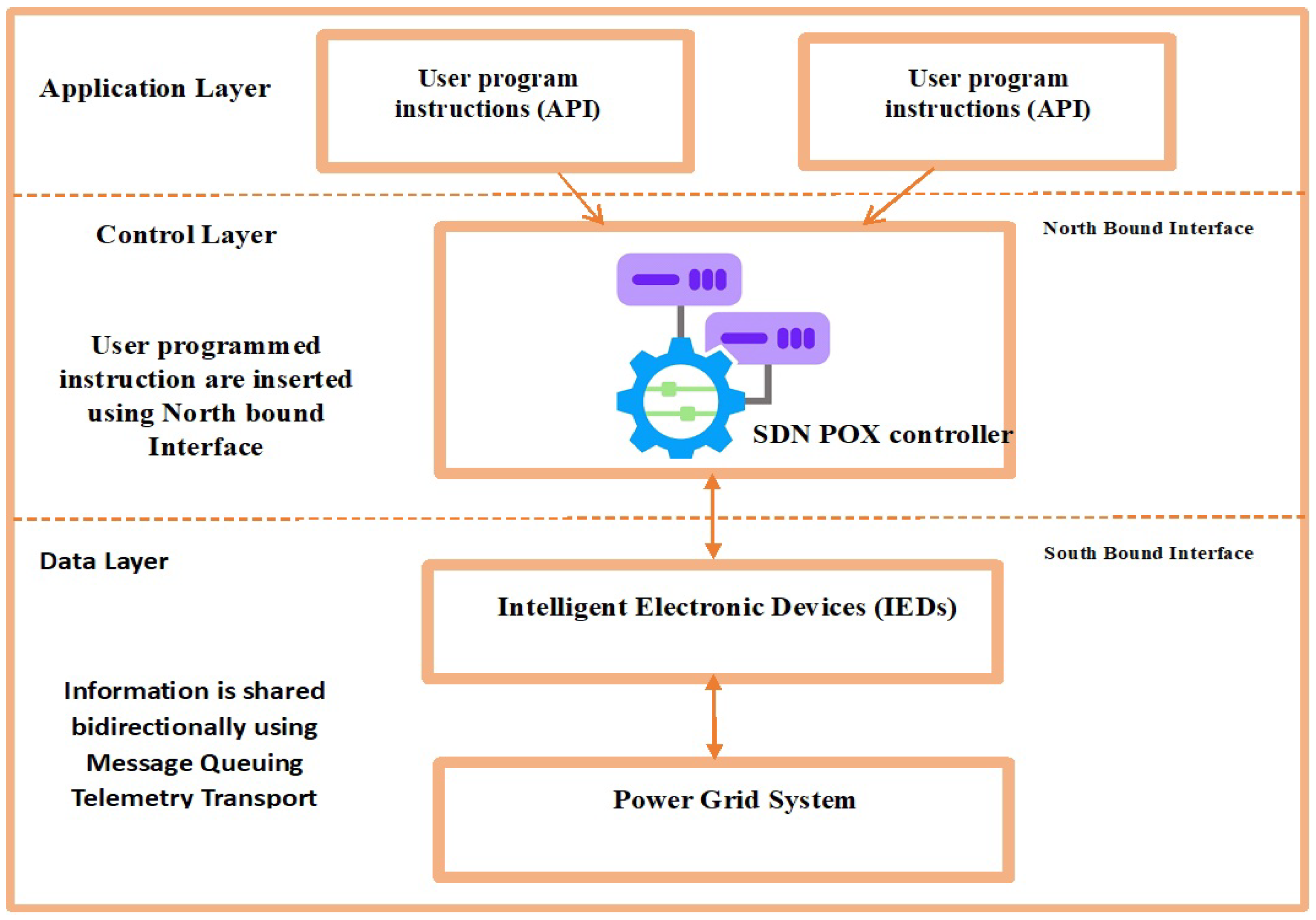
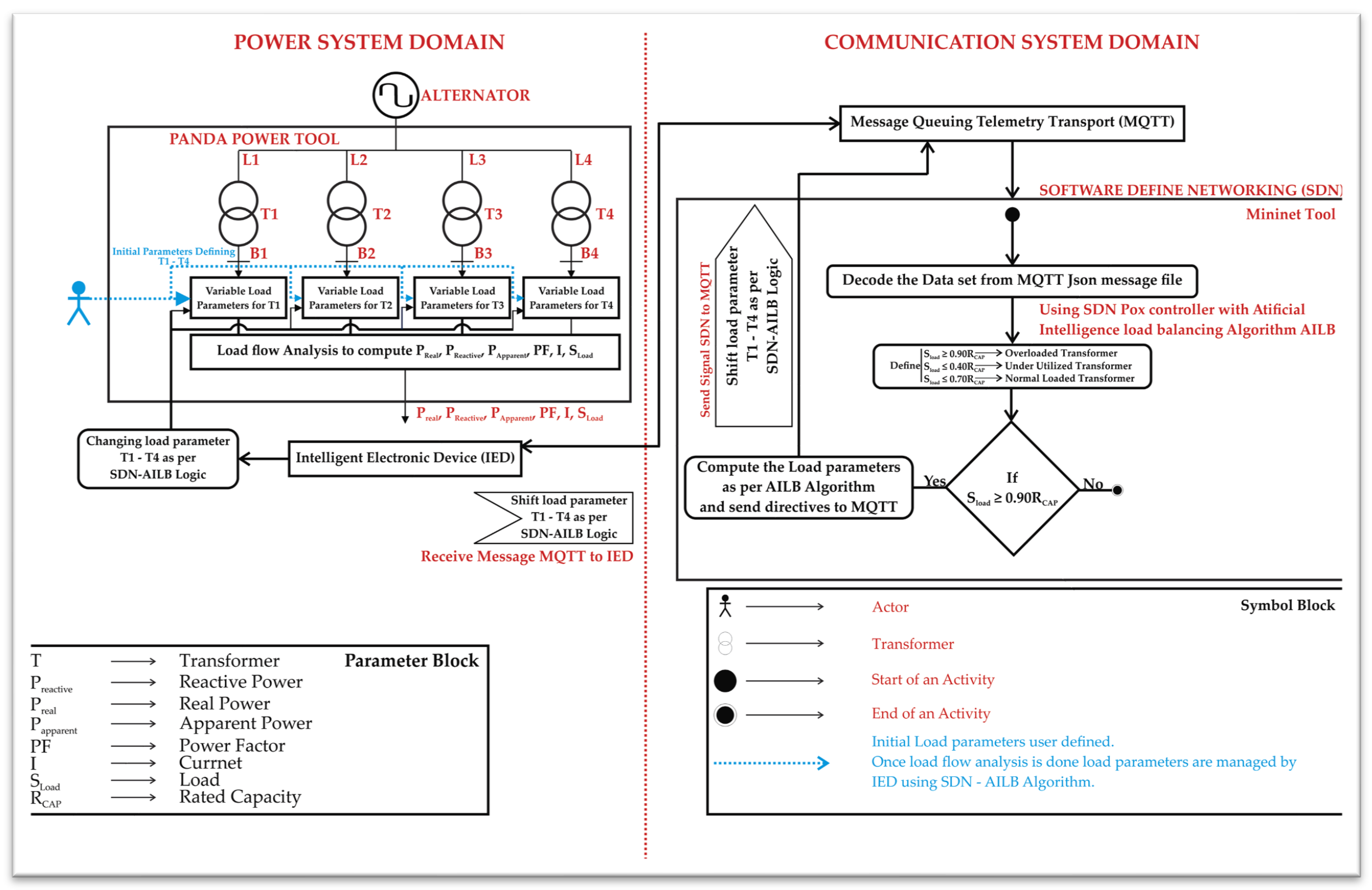
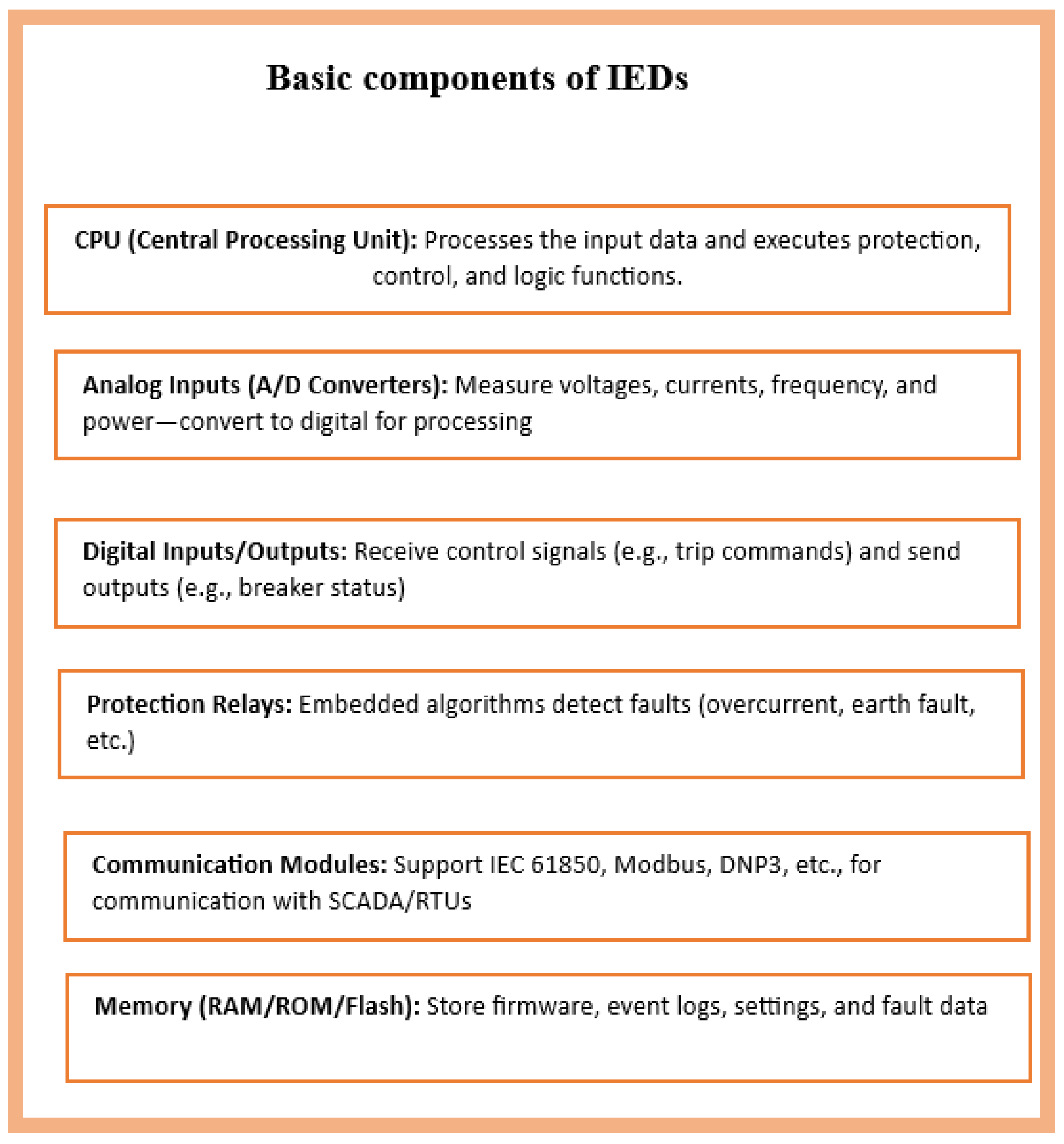
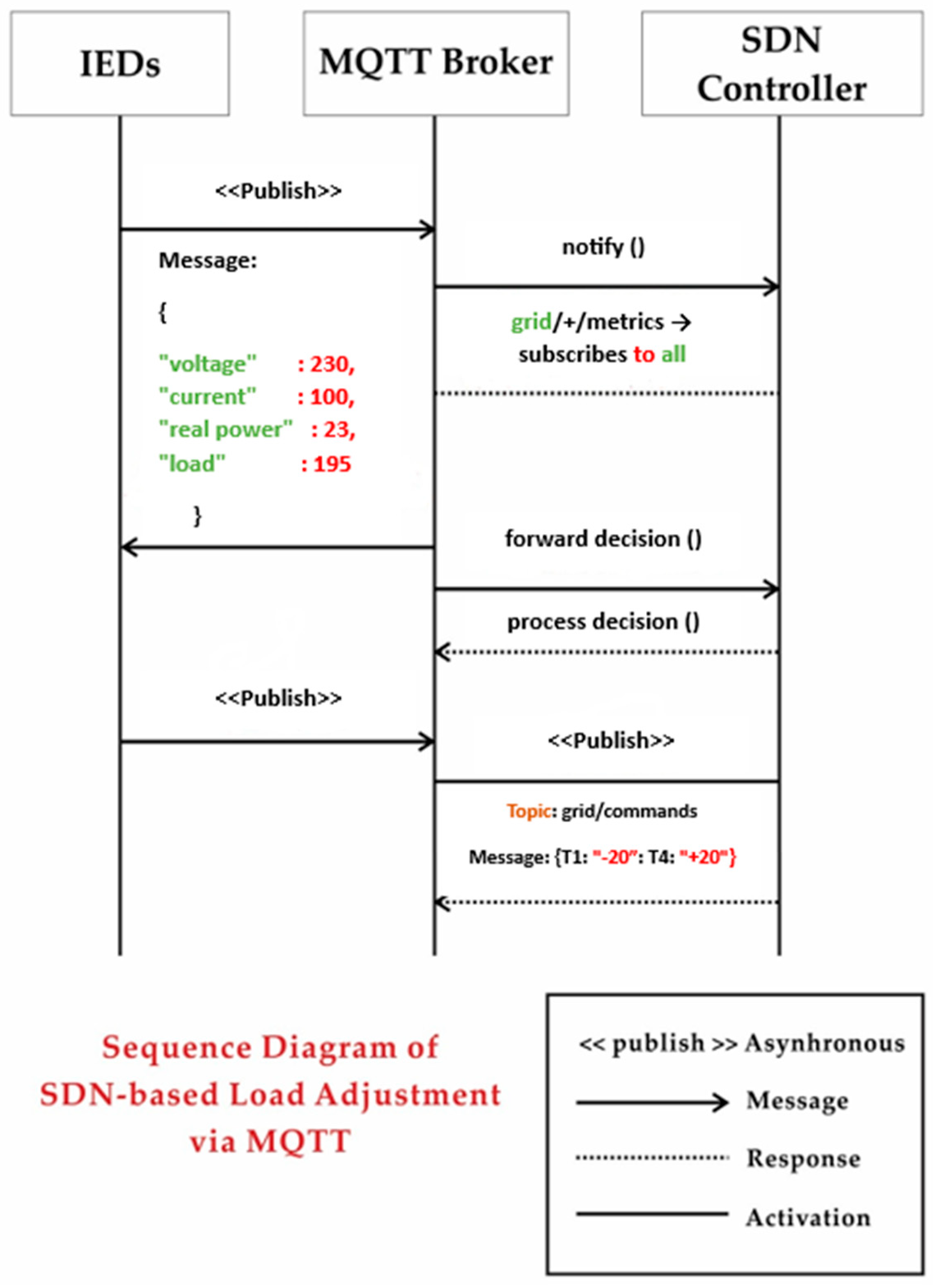
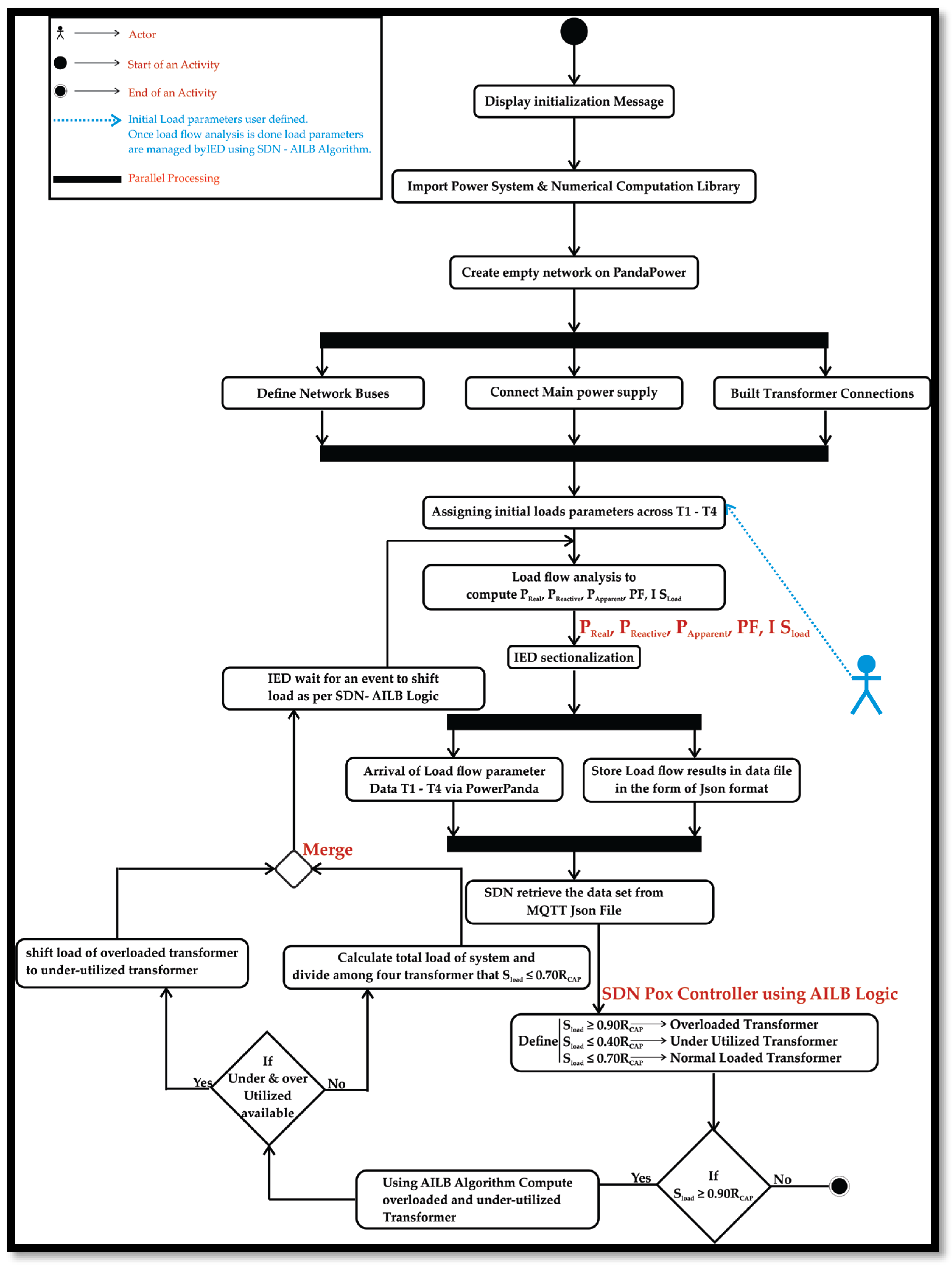
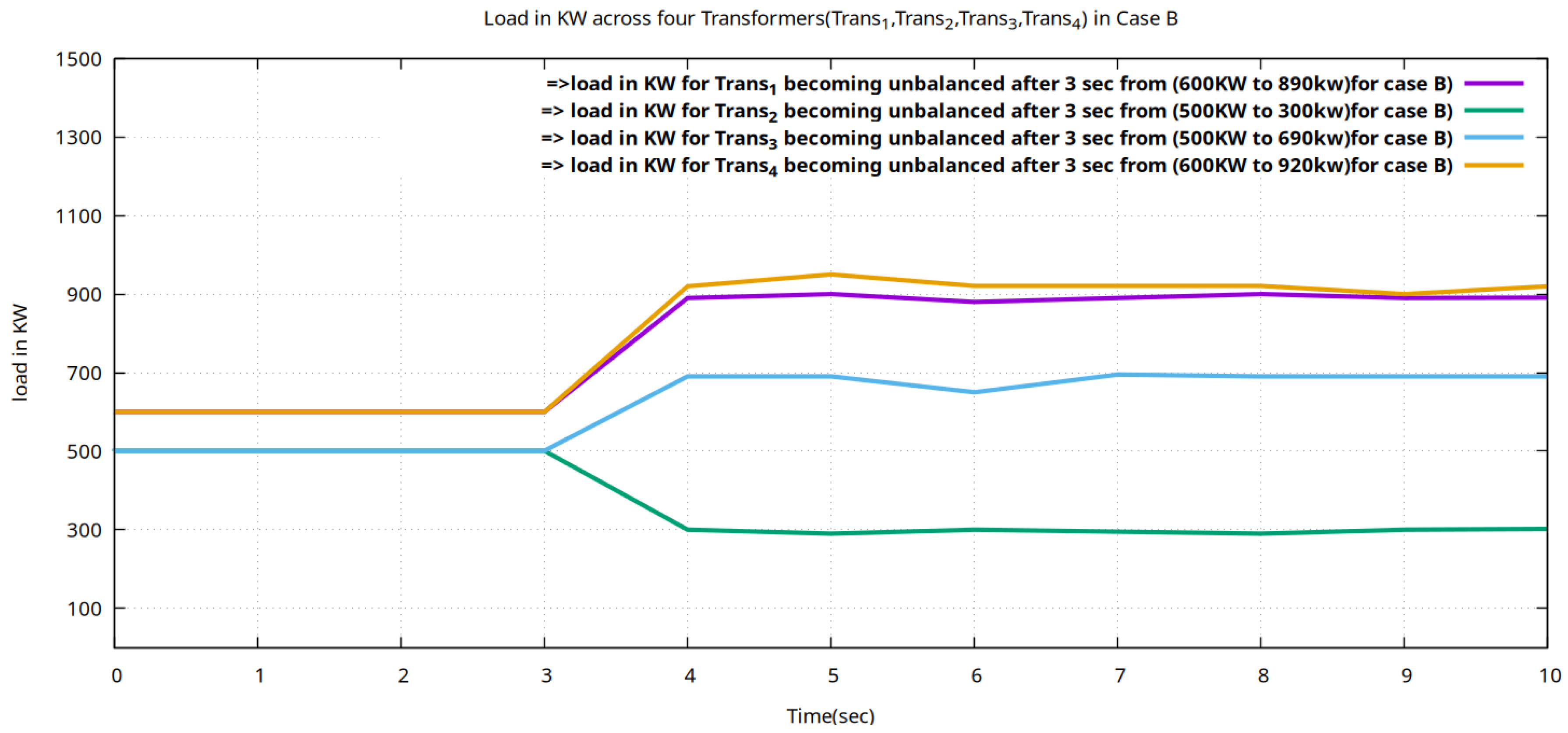
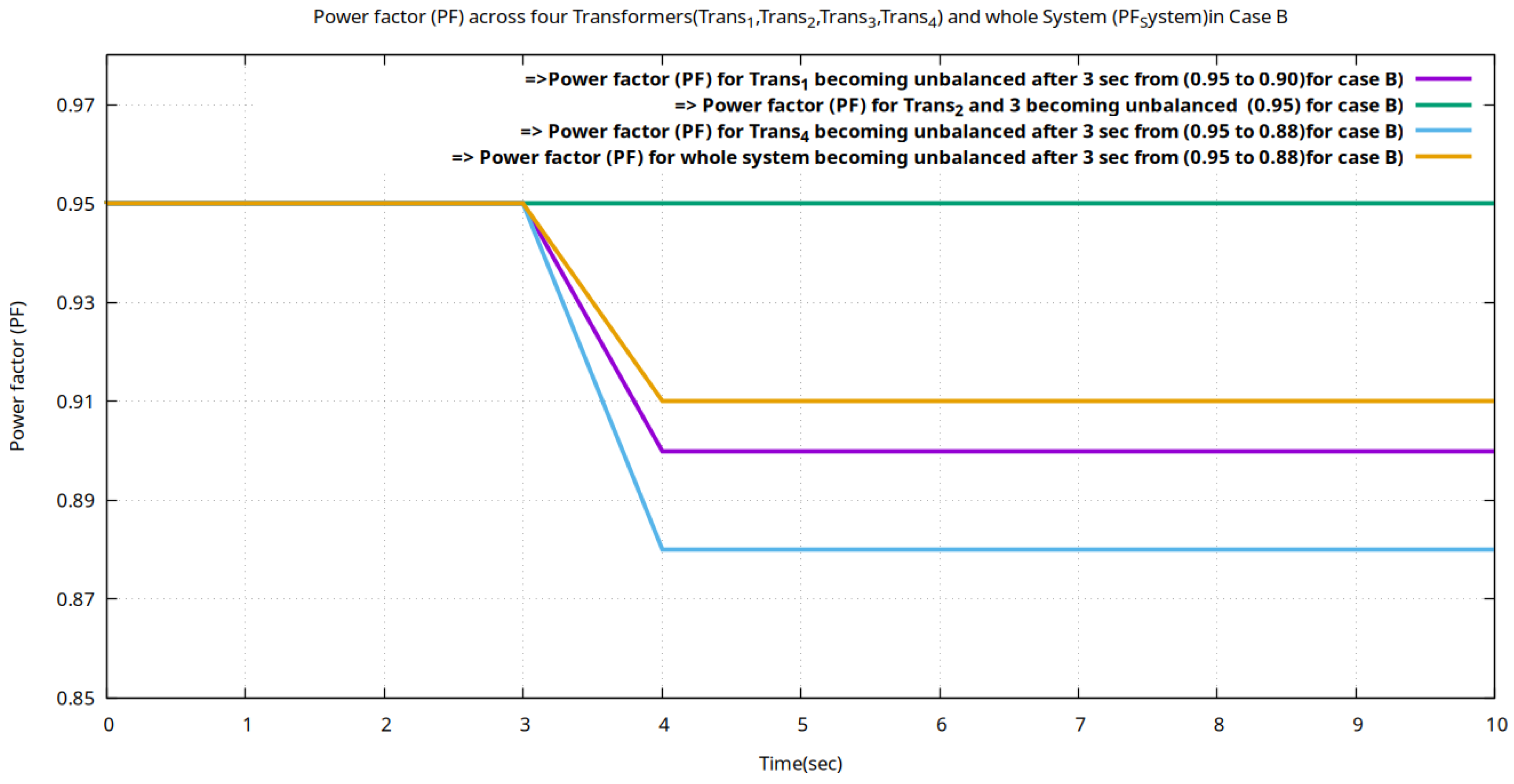
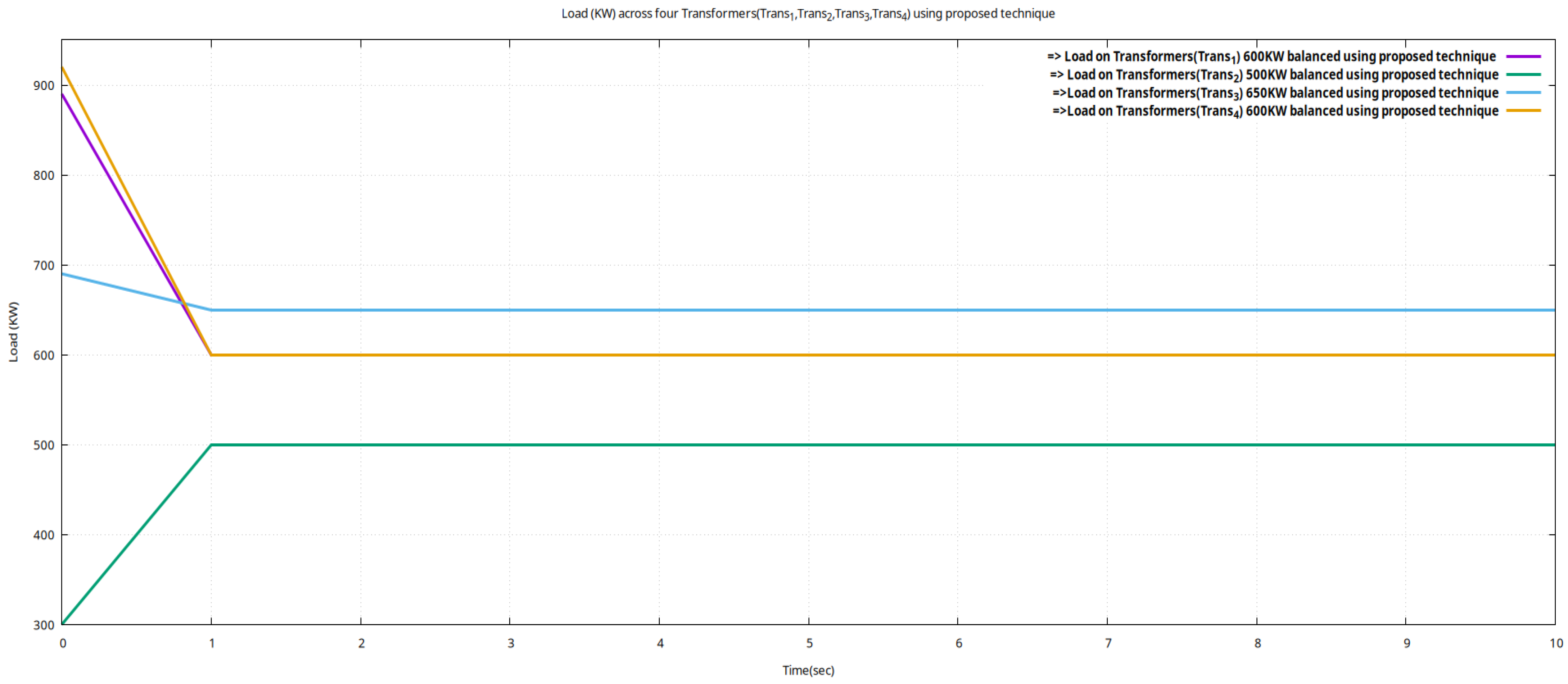
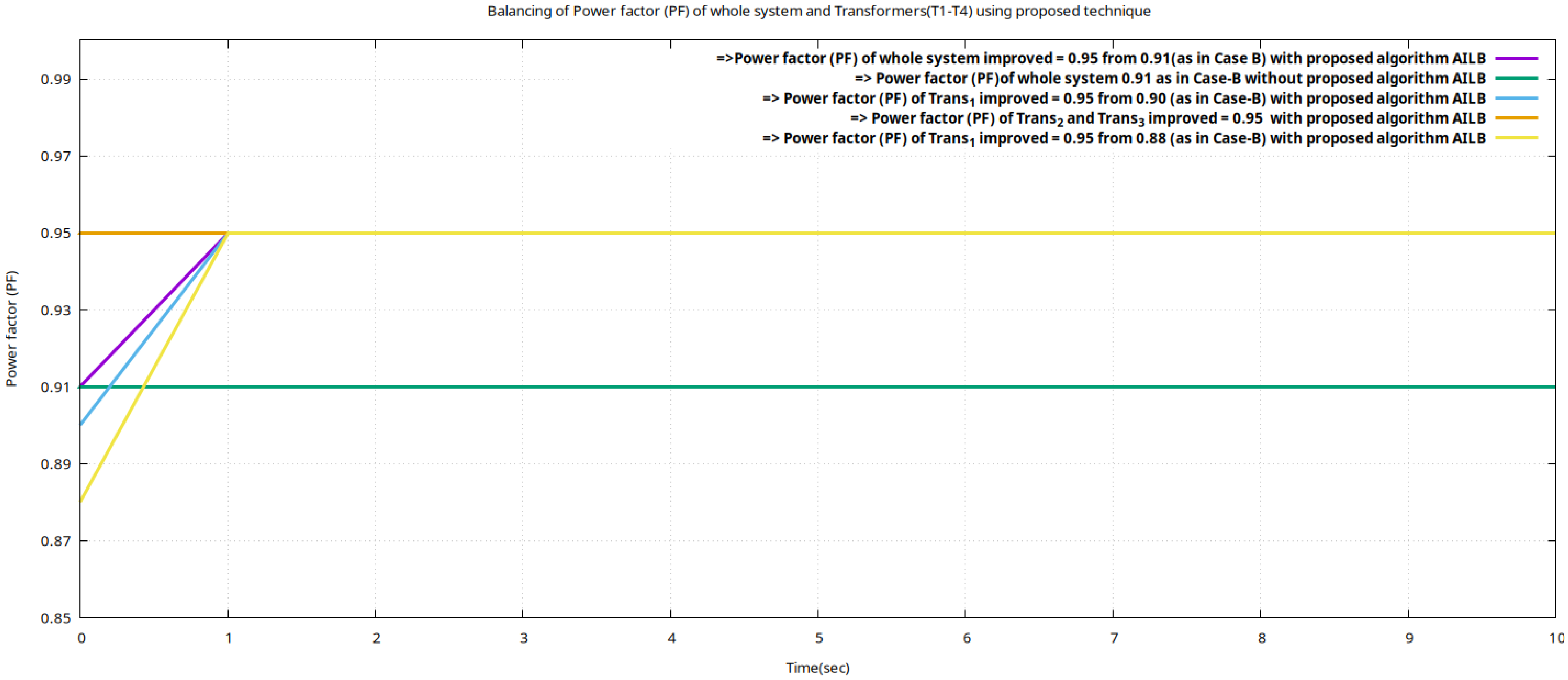
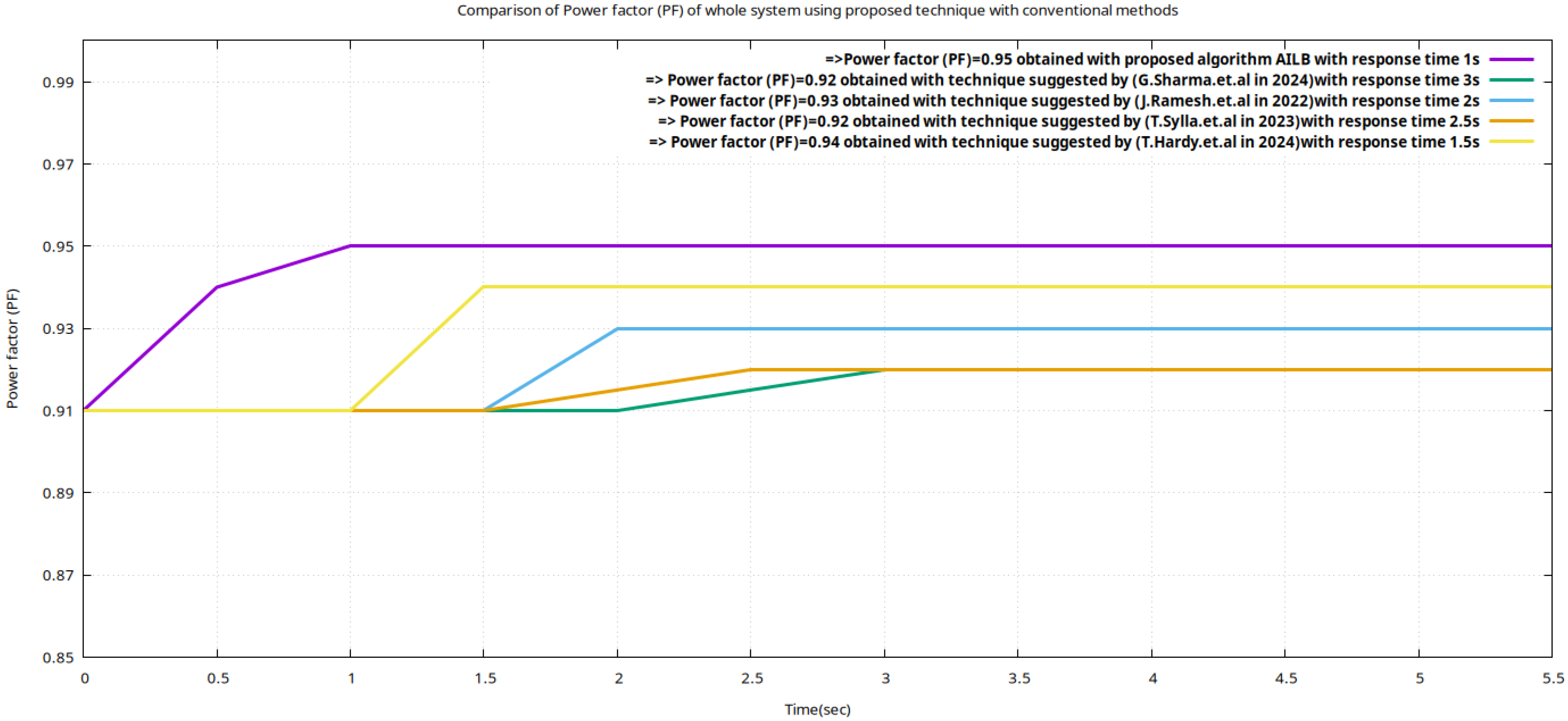
| References | Contribution of Author’s Technique | Limitation and Comparison with the Proposed Technique |
|---|---|---|
| A. Akrami et al. [12] | This study highlights the different operational evaluation methods to enhance power system flexibility. | Lacks practical implementations and no work on the implementation of SDN or IED integration for increased flexibility of power system. |
| M.B. Hadi et al. [13] | This study provides a review of modelling techniques. | Focused heavily on theoretical detail of power system failure with negligible coverage of modern communication technologies such as SDN or MQTT. |
| H. Tiismus et al. [14] | Analyses the impact of renewable energy and provides mitigation techniques. | No work on AI-based techniques to balance the load. |
| M.M. Rehman et al. [15] | Proposes methods for quantifying the flexibility of power grids at the planning and operation stages. | Lacks practical implementations and no work on the implementation of SDN or IEDs. |
| T. Heggarty et al. [16] | Presents a categorization of flexibility resources and requirements under the smart grid. | No work on AI-based techniques to balance the load. |
| O.M. Babatunde et al. [17] | Advancements in renewable energy systems that influence grid flexibility. | No integration of SDN, AI-driven management, or IED data analysis. |
| O.T. Ojo et al. [18] | This study explains the demand response and storage systems to improve grid flexibility. | Does not explain the intelligent load redistribution or network optimization using SDN. |
| N. Hinov et al. [19] | Design of smart converters for smart energy management. | No real-time communication protocols like MQTT or SDN used. |
| J.J. Moreno Escobar et al. [20] | Review the linking SDN to the grid system. | Lacks practical implementations. |
| R. Chaudhary et al. [21] | Analysis of SDN architecture in smart grids. | No real-time power system simulations like Panda_Power or MQTT. |
| C. Urrea et al. [22] | Using SDN to optimize network flows in an IoT-based industrial system. | No power simulation is performed. |
| A. Wendneso et al. [23] | SDN’s fault tolerance and scalability in power grids. | Lacks implementation of frameworks such as IEDs and MQTT-based data exchange. |
| M.B. Mohande et al. [24] | Provides modelling of matrices (generation-side, demand-side, and grid-side). | No integration of SDN to automate flexibility assessment. |
| S. Impram et al. [25] | Operational flexibility and scenario modelling. | The system is modelled conventionally, without AI control logic or via SDN. |
| A. Bretas et al. [26] | SDN security layers, flaws in flow tables, controller attacks, and data integrity threats. | No simulation of SDN in load management scenarios. |
| D. Agnew et al. [27] | The use of machine learning techniques to overcome the threats and mitigation techniques in SDN-controlled grid environments. | No integration of IEDs and MQTT-based brokers. |
| P. Kumar et al. [28] | SDN with digital twin models to improve energy dispatch. | Lacks consideration of specific transformer-level decision loops that employ feedback via MQTT or IEDs. |
| Zion Market Research [29] | Role of IEDs in energy distribution. | Transformer interaction modelling is absent. |
| IMARC Group et al. [30] | Examines IEDs in distribution and transmission networks. | AI-based load optimization, SDN controllers, and data-gathering architectures were not discussed. |
| Introspective Market Research et al. [31] | Evaluates IED deployment trends, drivers, and technology prospects in grid automation and digital substations. | No integration of IEDs with co-simulation platforms, SDN, or MQTT. |
| S. Qi et al. [32] | Adoption of IEDs for reducing operational costs in smart grids. | Lacks technical validation of IEDs’ support for real-time control, AI, or SDN-based management. |
| M.Emmanuel et al. [33] | Load flow and transient stability modelling using Python-based tools. | No integration of messaging layers like MQTT or network controllers like POX/SDN. |
| S. Shahzad et al. [34] | Co-simulation using HELICS to synchronize grid models and communication frameworks. | No AI-based load decision logic or demonstration with MQTT-enabled IED communication. |
| Umar Taiwo Salman et al. [35] | Combines artificial intelligence algorithms for transformer load forecasting and balance decisions with IED-based data monitoring. | No integration with SDN-based control planes or communication brokers; offline modelling of implementation. |
| H. R. Khan et al. [36] | Suggests an MQTT-based architecture that monitors and powers quality parameters in real time. | Does not apply load balancing methods or combine MQTT communications with SDN. |
| M.U. Shaileshwari et al. [37] | Examines the use of synchronized phasor readings for better operational decision-making. | Does not integrate with real-time data-sharing protocols such as MQTT or SDN control planes. |
| Thomas Pfeiffenberger et al. [38] | Optimizes grid load balancing by combining SDN with fuzzy logic. | Does not incorporate IEDs or MQTT. |
| B. Zhou et al. [39] | Explains how to acquire transformer health data with low latency using MQTT. | Does not simulate the AI-based redistribution or SDN-driven control choices. |
| M.R. Msane et al. [40] | Automates decisions about distributed load shedding and shifting in smart grid nodes using reinforcement learning. | The method is decentralized and does not provide support for controller-based SDN installation. |
| G. Sharma et al. [41] | Intelligent load balancing in smart grids using SDN + fuzzy logic. | No MQTT or IED feedback, no simulation model. |
| J. Ramesh et al. [42] | Real-time load estimation on transformers using IED data + AI for balancing. | No programmable SDN control or flow shifting. |
| T. Sylla et al. [43] | A platform for monitoring smart substations using SDN and MQTT. | No load shifting or AI-based redistribution. |
| T. Hardy et al. [44] | Synchronizes cyber and physical layers using HELICS and Power_Sim. | No AI or SDN-based policy logic. |
| Parameters | Descriptions | Values |
|---|---|---|
| Trans (1–4) | Number of transformers | 4 |
| Rcap | Rated capacity | I.0 MVA for all four transformers |
| V | Nominal voltage | 11 kv |
| F | Frequency | 50 hz |
| ALTcap | Alternator rated capacity | 50 MVA |
| SDN controller | Type of SDN controller used | POX |
| Overloading | Load threshold for overloading | ≥0.90 |
| Under loading | Load threshold for under loading | ≤0.40 |
| Balanced loading | Load threshold for balanced loading | ≤0.70 |
| IED configuration | Measurement (voltage, current, real power, apparent power, and power factor) | V, I, P, S, PF |
| Protocol | Integration between Pandapower and SDN | MQTT via IEDs |
| MQTT address | Local host | Port number 1883 |
| MQTT (TOPICS) | Addressing mechanism adopted | Grid/load, Grid/status |
| Transformer | RCap (KVA) | %L | PReal (KW) | PApparent (KVA) | PReactive (KVAR) | Current (A) | Voltage (V) | PF |
|---|---|---|---|---|---|---|---|---|
| Trans_1 | 1000 | 60 | 600 | 631.59 | 204.9 | 910.19 | 400 | 0.95 |
| Trans_2 | 1000 | 50 | 500 | 526.309 | 165.29 | 758.49 | 400 | 0.95 |
| Trans_3 | 1000 | 50 | 500 | 526.309 | 165.29 | 758.49 | 400 | 0.95 |
| Trans_4 | 1000 | 60 | 600 | 631.59 | 204.9 | 910.19 | 400 | 0.95 |
| Total | 1000 | - | 2200 | 2315.79 | 740.599 | - | 400 | 0.95 (Bal) |
| Transformer | RCap (KVA) | %L | PReal (KW) | PApparent (KVA) | PReactive (KVAR) | Current (A) | Voltage (V) | PF |
|---|---|---|---|---|---|---|---|---|
| Trans_1 | 1000 | 89 | 890 | 988.89 | 430.79 | 1429.49 | 400 | 0.90 |
| Trans_2 | 1000 | 30 | 300 | 315.79 | 98.19 | 456.59 | 400 | 0.95 |
| Trans_3 | 1000 | 69 | 690 | 726.29 | 227.29 | 1047.59 | 400 | 0.95 |
| Trans_4 | 1000 | 92 | 920 | 1045.49 | 456.89 | 1510.11 | 400 | 0.88 |
| Total | 1000 | - | 2800 | 3076.49 | 1213.11 | - | 400 | 0.91 (fall) |
| Research Technique | PReal (KW) | PApparent (KVA) | PReactive (KVAR) | PF | Response Time |
|---|---|---|---|---|---|
| G. Sharma et al. [41] | 2800 | 3076.91 | 1123.39 | 0.92 | 3.0 s |
| J. Ramesh et al. [42] | 2800 | 3043.49 | 1066.49 | 0.93 | 2.0 s |
| T. Sylla et al. [43] | 2800 | 3010.79 | 999.89 | 0.92 | 2.5 s |
| T. Hardy et al. [44] | 2800 | 3043.49 | 1066.49 | 0.94 | 1.5 s |
| Proposed Framework (AILB) | 2800 | 2978.69 | 882.69 | 0.95 (Bal) | 1.0 s |
Disclaimer/Publisher’s Note: The statements, opinions and data contained in all publications are solely those of the individual author(s) and contributor(s) and not of MDPI and/or the editor(s). MDPI and/or the editor(s) disclaim responsibility for any injury to people or property resulting from any ideas, methods, instructions or products referred to in the content. |
© 2025 by the authors. Licensee MDPI, Basel, Switzerland. This article is an open access article distributed under the terms and conditions of the Creative Commons Attribution (CC BY) license (https://creativecommons.org/licenses/by/4.0/).
Share and Cite
Mehmood, K.T.; Hussain, M.M. Dynamic Load Management in Modern Grid Systems Using an Intelligent SDN-Based Framework. Energies 2025, 18, 3001. https://doi.org/10.3390/en18123001
Mehmood KT, Hussain MM. Dynamic Load Management in Modern Grid Systems Using an Intelligent SDN-Based Framework. Energies. 2025; 18(12):3001. https://doi.org/10.3390/en18123001
Chicago/Turabian StyleMehmood, Khawaja Tahir, and Muhammad Majid Hussain. 2025. "Dynamic Load Management in Modern Grid Systems Using an Intelligent SDN-Based Framework" Energies 18, no. 12: 3001. https://doi.org/10.3390/en18123001
APA StyleMehmood, K. T., & Hussain, M. M. (2025). Dynamic Load Management in Modern Grid Systems Using an Intelligent SDN-Based Framework. Energies, 18(12), 3001. https://doi.org/10.3390/en18123001







